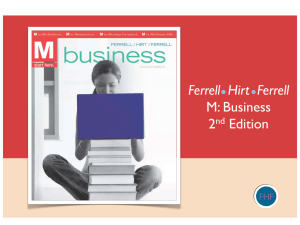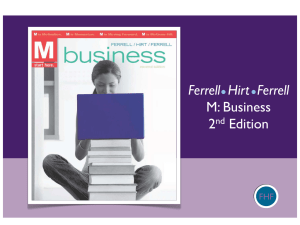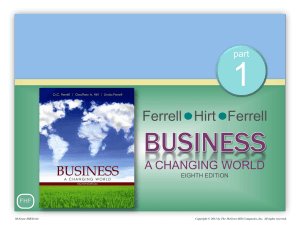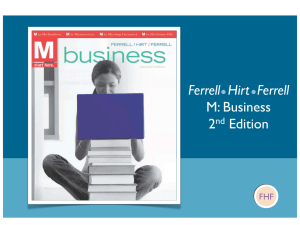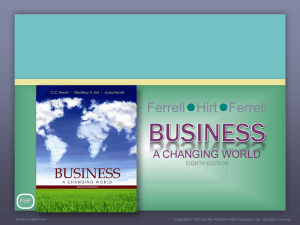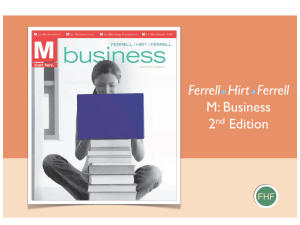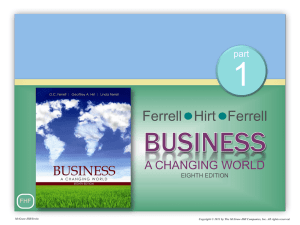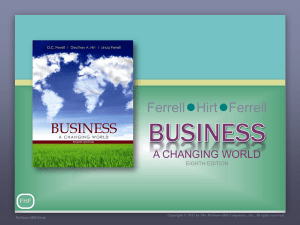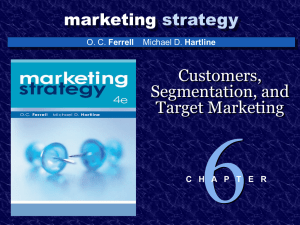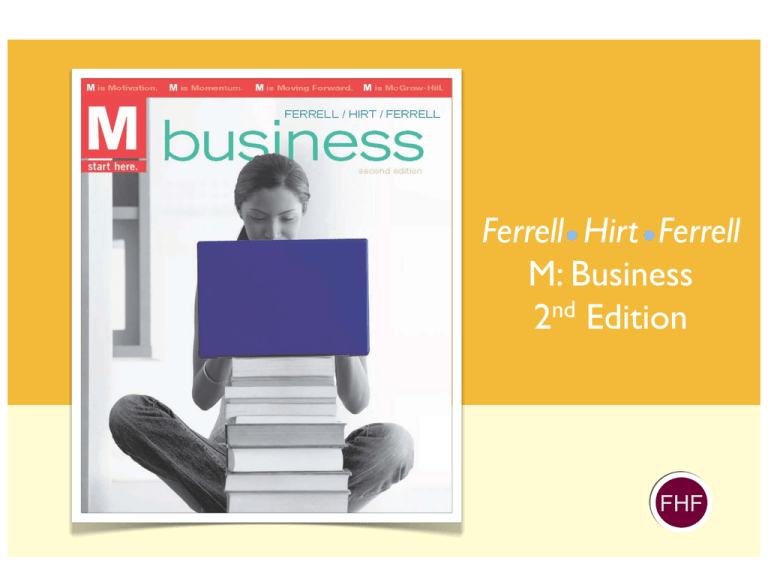
Ferrell Hirt Ferrell
M: Business
nd
2 Edition
FHF
Customer-Driven Marketing
FHF
McGraw-Hill/Irwin
Copyright © 2011 by the McGraw-Hill Companies, Inc. All rights reserved.
Marketing
[
A group of activities designed to
expedite transactions by creating,
distributing, pricing, and promoting
goods, services, and ideas
]
Creates value by allowing individuals and organizations to obtain what they need and want
FHF
12-3
Marketing is NOT
• Manipulating consumers
• Just selling & advertising
Marketing IS
• A systematic approach to satisfying consumers
FHF
12-4
Exchange
[
The act of giving up one thing
(money, credit, labor, goods) in return
(exchange) for something else (goods,
services, or ideas)
]
FHF
12-5
FHF
The Exchange Process
12-6
The New Marketing Environment in Retail
Permanent discounts (Wal-Mart’s model)
Taking market share rather than focusing on growth
• Some stores are differentiating through going
upscale
• Some are opening new stores to get greater
market share
Focus on value
FHF
12-7
Functions of Marketing
• Buying
• Selling
• Transporting
• Storing
• Grading
• Financing
• Marketing research
• Risk-taking
FHF
12-8
• The idea that an organization should try to
satisfy customers’ needs through coordinated
activities that also allow it to achieve its own
goals.
• Wal-Mart’s slogan “Save Money, Live Better”
The Marketing Concept
FHF
12-9
Yodle
Founded in 2005
Raised $25 million in venture capital
Provides advertising services for small businesses
• Online promotion
• Personalized content
• Tracks success of advertising efforts
FHF
12-10
Customer-Contact Employees
Must know what customers want
They are not selling goods and services, but:
• Ideas
• Benefits
• Philosophies
• Experiences
Customers’ perception of value= Level of success
FHF
12-11
Marketing Goals
• Customer satisfaction
• Achieve business objectives
• Boost productivity
• Reduce costs
• Capture market share
FHF
12-12
Evolution of the Marketing Concept
Production Orientation
• 19th Century
• Manufacturing efficiency
Sales Orientation
• Early 20th Century
• Supply exceeds demand -need to “sell” products
Marketing Orientation
• 1950s
• First determine what customers want
FHF
12-13
Marketing Orientation
An approach requiring organizations to
gather information about customer
needs, share information across firm,
use information to build long-term
relationships with customers
[
]
FHF
12-14
Marketing Strategy
A plan of action for developing, pricing, distributing, and promoting
products meeting the needs of specific customers.
Specialty’s Café and Bakery
• 25 bakery/café’s in U.S.
• Introduced online ordering in 2009 in
response to slow sales
• Now 40% of all orders are online
• Customers customize orders and pick them up
without waiting
FHF
12-15
Market
A group of people who have a need, purchasing power, and the desire
and authority to spend money on goods, services, and ideas
Target Market
• A more specific group of consumers on whose needs and wants a
company focuses its marketing efforts
FHF
12-16
A firm tries to appeal to all consumers and
assumes that they all have similar needs
• Salt, sugar, flour, white bread are all examples of
products that typically are sold using a total market
approach
Total-Market Approach
FHF
12-17
Market Segmentation
A strategy to divide the total market into groups of
people with relatively similar product needs
Market segment
• A collection of individuals, groups or organizations
sharing one or more characteristics thus having
relatively similar needs and desires for products.
FHF
12-18
Segmentation Approaches
Segmentation Approaches
Concentration Approach
• A market segmentation strategy whereby a company develops
one marketing strategy approach for a single market segment
Multisegment Approach
• A market segmentation strategy whereby a company aims its
efforts at two or more segments, developing a marketing
strategy for each
FHF
12-19
Niche Marketing
A narrow segment focus usually on one small well-defined
group with a unique and specific set of needs.
Inland Marine Supply
• Based in Houston
• Fills grocery orders for ships with limited time at dock
• Delivers to ships in refrigerated vans
• Small added fee
FHF
12-20
FHF
Target Market Strategies
12-21
Bases for Market Segmentation
• Demographic
• Geographic
• Psychographic
• Behavioristic
FHF
12-22
FHF
Developing the Marketing Mix
12-23
Product
A good, service or idea that has
tangible and intangible attributes that
provide satisfaction and benefits to
consumers
[
]
FHF
12-24
Price
[
A value placed on a product or
service that is exchanged
between a buyer and seller
]
FHF
12-25
Distribution
[
Making products available to
consumers in the quantities and
locations desired
]
FHF
12-26
Mobile Shopping
Prevalence of smart phones have led to more online shopping
• Amazon paired with iPhone to allow customers to shop for
books online, and to read information about products
• Sears even allows consumers to shop for refrigerators online
Customers expect online shopping to be available and easy
FHF
12-27
Promotion
A persuasive form of communication that
attempts to expedite a marketing exchange by
influencing individuals and organizations to
accept goods, services, and ideas
[
]
FHF
12-28
Marketing Research
Systematic and objective process to collect information about
potential customers
• Guides marketing decisions
FHF
12-29
Collecting Data
Primary data
• Marketing information that is observed, recorded or
collected directly from respondents (consumers).
Secondary data
• Information compiled inside or outside the
organization for some purpose other than changing
the current situation
FHF
12-30
Buying Behavior
[
Decision processes and actions of
people who purchase and use products
]
FHF
12-31
Psychological Variables for Buying Behavior
Perception
• Process by which a person selects, organizes, and
interprets information received from one’s senses.
(hearing a radio ad, touching a product)
Learning
• Brings changes in behavior based on information
and experience
Attitude
• Positive or negative feelings about something
Personality
• Individuals distinguishing character traits,
attitudes, or habits
FHF
12-32
Social Variables for Buying Behavior
Social Roles
• Set of expectations of individuals based on some
position they occupy
Reference Groups
• Groups with whom buyers identify and whose values
or attitudes they adopt
Social Classes
• Ranking of people into higher or lower positions of
respect
Culture
• Integrated, accepted pattern of behavior including
thought, speech, beliefs, actions and artifacts
FHF
12-33
Understanding Buying Behavior
Trying to understand consumers is the best way to satisfy
them
• No exact tools
FHF
12-34
The Marketing Environment
External forces that directly and indirectly affect
marketing strategy
• Political, legal and regulatory forces
• Social forces
• Competitive and economic forces
• Technological forces
FHF
12-35
Green Marketing
Increasing trend toward green products
“Green” versions of popular brands
Terra Choice is an environmental marketing agency
Released a report “The Seven Sins of Greenwashing”
Very little regulation of green marketing
Consumers must be aware to make responsible choices
FHF
12-36
The Marketing Mix and Marketing Environment FHF
12-37
FHF
12-38

